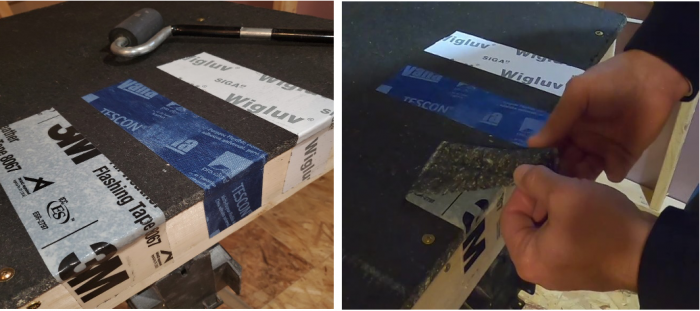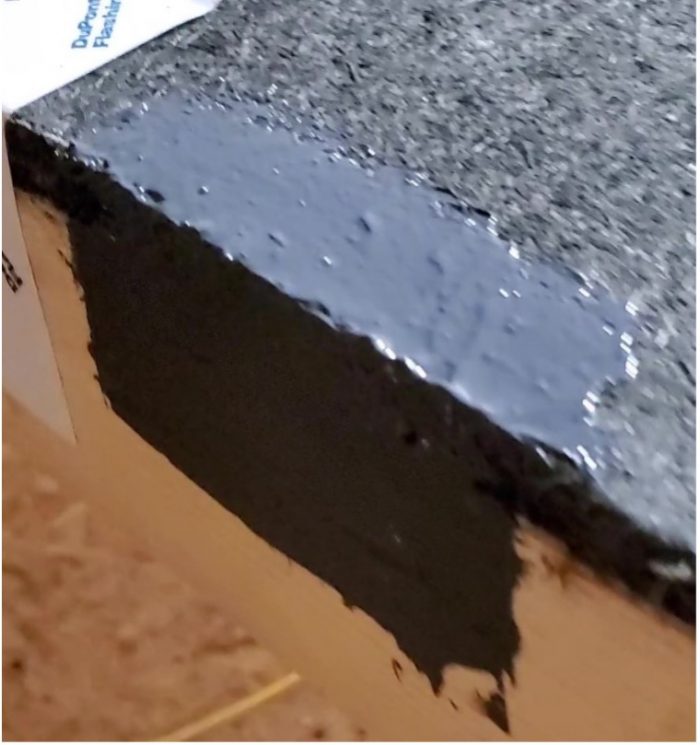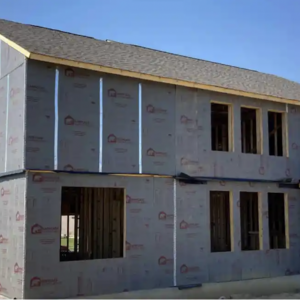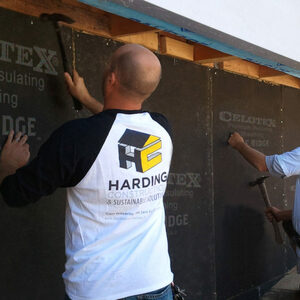
When I first started in the trades as an electrician back in the mid 1990s, I worked for contractors who liked to use buffalo board sheathing. I suspect the product was given this name because of its resemblance to buffalo chips. I’ve heard it called several other names including bildrite, beaver board, brickboard, and bagasse but it is best known as fiberboard sheathing.
Fiberboard sheathing is primarily made of wood fibers that are combined with a binder. (Don’t confuse fiberboard sheathing with fiberboard insulation, such as Gutex.) Other additives improve moisture- and fire-resistance. It does not have the density of other sheathing products, which gives fiberboard a higher R-value of approximately R-2.5 per in. It has a perm rating of 5 to 20, depending on the manufacturer. Because it is a lower-density sheathing, it does not have good shear strength and usually requires some additional form of bracing. (That said, there are some fiberboard products on the market that are rated as structural sheathing.) When installing new, manufacturers recommend adding a house wrap or other water-resistive barrier (WRB) as soon as possible.
Working with fiberboard sheathing
Fiberboard has been around for more than 100 years. It became popular in the 1950s in pockets around North America. I haven’t seen it used in new construction in my market since the late 1990s, although the product is in stock at my local lumberyard. When lumber prices spiked, I suspect they purchased a bunch as an alternative to plywood and OSB. For $12 I bought one 4-ft. by 8-ft. sheet to test.

I remember working on a home several years ago, where the cladding was installed over the fiberboard without any type of house wrap. More recently, I was involved in work on a couple older homes with fiberboard. The adjacent photo is of one of those projects. An air leak on an exterior wall caused the fiberboard to become a condensing surface during the winter. Although I didn’t have to work with the sheathing on those projects, I got thinking about how to install a new window, or tie in an addition when fiberboard is present. What if there was no house wrap? What do we need to do to make the water and air control layers continuous?
Air- and vapor-control measures
To answer this question, I decided to conduct a little wing-nut testing. If anything would work, it would be one of the better tapes on the market. So, I built a small mock-up wall with 2x framing and attached a piece of fiberboard sheathing. I ran my three best tapes—Siga’s Wigluv, Pro Clima’s Tescon Vanna, and 3M’s 8067—from the fiberboard to the wood framing. I rolled it and let it set for a few hours to achieve a good bond between the tape and the two surfaces. Then, I tried to pull the tape off. All the tapes easily pulled away from the fiberboard but stuck tenaciously to the 2x wood framing. If the tape was never disturbed and never got wet, it might stay in place, but I wouldn’t guarantee it.
Next, I tried using a primer designed to be used with a different type of tape, namely Henry Blueskin. I sprayed the primer on the fiberboard, allowed it to dry for a few minutes, then applied a piece of 3M’s 8067. The primer increased the hold substantially. As seen in the photos below, there were two pieces of 3M tape; the left piece was adhered to the primer, the right had no primer. Much less fiber was pulled off the primed piece. I’m assuming the primer locked the fibers in place. I have much more confidence in the primed area holding the tape over time.


A fluid-applied membrane may also work. Products like Zip’s Liquid Flash or Prosoco’s Fast Flash are basically liquid tapes. I tried Zip’s product on part of the unprimed fiberboard. It held better than the tape but not as good as the primed-and-taped method.

My takeaway
My preference is to not use fiberboard sheathing but there are a lot of older houses in my market with the product installed. My goal has always been to leave a house I work on better than I found it. Coming up with a few strategies when working with uncommon building materials can go a long way toward achieving that goal.
________________________________________________________________________
Randy Williams is a builder and energy rater based in Grand Rapids, Minnesota. Photos courtesy of the author.
Weekly Newsletter
Get building science and energy efficiency advice, plus special offers, in your inbox.















8 Comments
Great contribution--I'm always glad to see more wingnut testing.
Agreed, Charlie. I always say yes to pitches that include wingnutting.
Hey Charlie, I've got more written and more planned. Having fun with it.
How does this compare to "structural sheathing" or "insulated structural sheathing" ? For instance, the products made by OX or Barricade Building Products that include foil WRB attached to the panel or, in the case of insulated structural sheathing, also includes a foam insulation sheet (Barricade's product seems to use Neopor graphite polystyrene). These structural panels claim to have proper code complaint sheer strength and can be used (when taped) as the vapor, air and water barrier. The insulated product seems to have the barrier on the front and back, which seems to avoid the issue many have with the ZIP insulated panels....
get a sample and you decide Nick- they retire far more nails to in theory achieve same sheathing value- caveat emptor- this is strictly a builders grade product IMO
Hi Nick,
Both the products you listed are very similar to Dow's SIS, a structurally insulated sheathing product. They all feature some sort of foam insulation product bonded to a heavy cardboard or thin wood panel used as the structural part of the assembly. I used Dow's SIS on a home I built back in 2009. This home was also insulated with CCSF. The assembly worked, but I didn't like nailing through the insulation, you couldn't see very well if the nail seated correctly. This is a much different product compared to fiberboard sheathing. The fiberboards I'm familiar with are not structural. Let-in wood bracing or metal strapping are common when using fiberboard. Fiberboard also has a very high perm rating; vapor can move through the assembly in either direction. The structural insulated sheathing products using foam insulations have a low perm rating, drying will mostly happen inward with these assemblies.
Anyone have any tips and tricks for working with fiberboard when you can only access the interior of the sheathing?
I have a late 40's era house that is sheathed with 1/2" fiberboard. There's a layer of 30 pound roofing felt on the exterior of the sheathing. The house is clad in brick.
I'm doing an interior gut remodel and a small addition. For the most part, the sheathing is not in bad shape. There are few places where it appears someone dropped a brick and it penetrated the fiberboard. There are also a few places where nails missed the studs. And for some reason, there are a few places where the sheathing seems to be pulling away from the bottom plate.
I'd like to insulate the cavities with mineral wool and then install a layer of 1" foam on the interior side of the studs to reduce thermal bridging. I've thought about trying to tape the seams in the sheathing and then caulk around the perimeter of the studs. I've also thought about cutting strips of an air and water barrier and stapling/taping it to the studs. I've also thought about using the Prosoco system to coat the interior of the sheathing and studs. Any thoughts?
I know spray foam is probably the best solution, but I have not been impressed by any of the local installers. Every project I've looked at in my area seems to have very inconsistent depth and foam quality.
robert79,
You may find some ideas that work in this article. It is about walls with no sheathing, but addresses the same issues:
https://www.greenbuildingadvisor.com/article/insulating-walls-in-an-old-house-with-no-sheathing
Log in or create an account to post a comment.
Sign up Log in